Sydney Games Anniversary: The Rivalry Between Jenny Thompson and Dara Torres
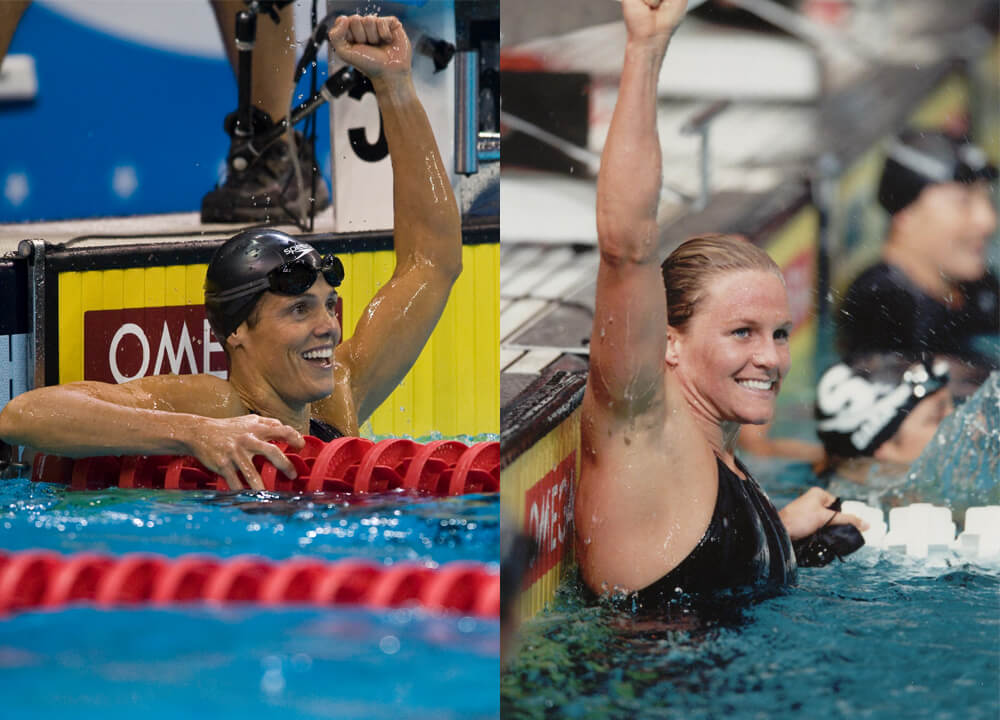
Sydney Games Anniversary: The Rivalry Between Jenny Thompson and Dara Torres
In September 2000, the United States went to work at the Olympic Games in Sydney with a star-studded lineup. Among the members of Team USA were Jenny Thompson and Dara Torres, whose rivalry had several intriguing storylines.
******************************
Like many rivalry stories, the tale of Jenny Thompson and Dara Torres is about opposites. Thompson was raised by a single mom where financial struggles were common. Torres was raised in Beverly Hills, money never an issue. Thompson is quiet and reserved, preferring to go unnoticed. Torres doesn’t mind the spotlight, and is never one to pass up the chance to promote her brand. Thompson went into the medical profession after her swimming days. Torres’ post-pool endeavors included broadcasting and modeling.
But in the water, there were few differences. They both moved through the water with world-class speed. They raced the same events. They possessed high intensity levels and aimed for lofty goals. And in the Olympic campaign of 2000, Thompson and Torres dueled in spectacular fashion – in and out of the water – and provided the sport with an all-time rivalry.
Torres fits the mold of one of those teenage sensations who frequently emerge in the swimming world. As a 14-year-old, Torres announced her presence in a major way by winning the national title in the 50 freestyle, a crown that required her to defeat Olympian Jill Sterkel. In a little more than 22 seconds, Torres made it known she would be a factor in the sprints. What couldn’t be predicted was the longevity she would eventually display.
Behind an equally efficient and powerful stroke, Torres punched her first Olympic ticket to a home Olympiad in Los Angeles in 1984. At those Games, where she was surrounded by veterans such as Mary T. Meagher, Rowdy Gaines and Tracy Caulkins, Torres garnered the first Olympic medal of her career, as the United States prevailed in the 400 freestyle relay.
Over the next four years, the success continued for Torres, who became an NCAA and Southeastern Conference champion for the University of Florida and earned her second Olympic nod for the 1988 Games in Seoul. At those Games, Torres won silver and bronze medals in relay action and finished seventh in the 100 freestyle.
Just after Seoul, Thompson started to emerge as a United States future hope, an identity claimed through three medals at the 1989 edition of the Pan Pacific Championships. In Tokyo, Thompson won gold in the 50 freestyle and took silver in the 100 freestyle to strengthen the American sprinting contingent.
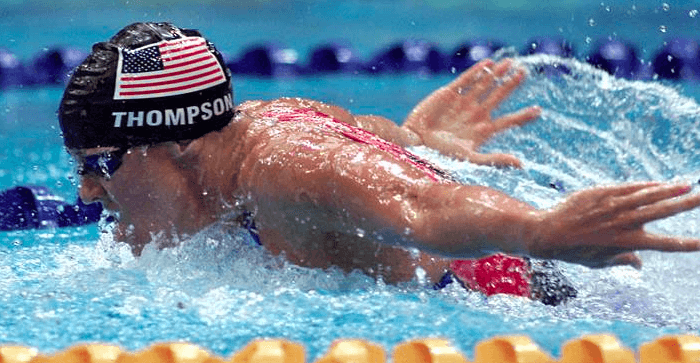
Photo Courtesy: Jenny Thompson Fan Page
It wasn’t until 1992, however, that Thompson and Torres competed at the same Olympics, albeit without crossing paths as competitors. While Thompson won the silver medal in the 100 freestyle and was fifth in the 50 freestyle, she joined Torres on the victorious 400 freestyle relay. But with Thompson recognized as one of the world’s rising stars, Torres was ready to retire, and any potential rivalry was impossible to foresee.
With Torres gone and Thompson recovered from nagging injuries that hampered her 1994 season, she again put her name on the global radar in 1995 by medaling in three Pan Pacs events, including a gold in the 100 freestyle. On the road to her second Olympic Games, Thompson appeared poised to strike in Atlanta.
“I’m pleased with how everything went,” Thompson said. “I think this was a good stepping stone toward the Olympics.”
The 1996 Olympic Trials were supposed to be a formality for Thompson. Entered in four events, she was expected to hop into the pool, take care of business and look ahead to the Games in Atlanta, where she could claim a fistful of medals. Instead, there was no way to describe Thompson’s performance in Indianapolis other than with one of the most-hated words in sports: Choke. The pressure got to Thompson, and when she struggled early on, a snowball of negativity became an avalanche of doubt.
Thompson entered her first event, the 100 freestyle, as the American-record holder and heavy favorite to win. But a third-place finish left Thompson with only relay duty in Atlanta and, more damning, damaged her psyche. She followed with a seventh-place finish in the 200 freestyle and a fourth-place finish in the 100 butterfly, and by the time the 50 freestyle arrived as her last event, Thompson was done. Her third-place finish in that event was, simply, a last kick to the gut.
“People automatically assumed I would make the Olympic team,” Thompson said. “I was a basket case. At those Trials, my mind was all over the place. Maybe I wanted something so bad, I lost my focus.”
Although Thompson qualified for the Atlanta Games in the 400 freestyle relay, the coaching staff also used her on the 400 medley relay and 800 freestyle relay, allowing Thompson to win three gold medals. More, she served as a mentor to the younger athletes on the Team USA roster, imparting her wisdom from previous international meets.
By rallying from a disastrous Olympic Trials to perform admirably at the Olympic Games revealed a toughness in Thompson that hadn’t been seen before. Her story was one of perseverance and making the best of a situation, and doing so in a fish bowl. Not surprising, Thompson’s tale was a major storyline of that summer.
“I’ve been proud of her in a lot of things, but how she handled the disappointment of how she finished at the Olympic Trials and the way she prepared for the Games, I think has taken an enormous amount of character,” said her coach, Richard Quick. “I really admire her because she hasn’t looked at the short side of things. She’s looked at the long side. It’s a tremendous honor to be on the Olympic team. It’s a tremendous honor to be on two Olympic teams. This is her second one. It carries a responsibility with it that Jenny recognizes. And she’s accepted that responsibility. She knows the best way to prepare is to race all these races as if she were swimming all her events. Instead of feeling sorry for herself, she has been ready to do anything she can for the U.S. as a relay member.”
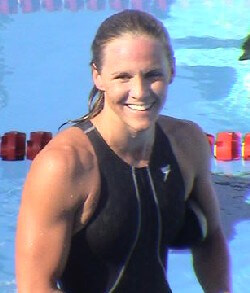 The disappointment of 1996 did not linger with Thompson, whose next three years were nothing short of remarkable. Between the 1997 and 1999 Pan Pacific Championships, Thompson totaled 12 medals, 11 of which were gold. At the 1999 version of the event in Sydney, where she won three solo golds and six overall titles, Thompson took down Meagher’s 18-year-old world record in the 100 butterfly.
The disappointment of 1996 did not linger with Thompson, whose next three years were nothing short of remarkable. Between the 1997 and 1999 Pan Pacific Championships, Thompson totaled 12 medals, 11 of which were gold. At the 1999 version of the event in Sydney, where she won three solo golds and six overall titles, Thompson took down Meagher’s 18-year-old world record in the 100 butterfly.
In between Pan Pacs, at the 1998 World Championships, Thompson was the dominant athlete. In addition to claiming world titles in the 100 freestyle and 100 butterfly, Thompson powered a pair of American relays to gold medals, and helped another relay to silver. The three years that followed her 1996 struggles clearly proved she had moved forward.
“It was probably the worst meet of my life,” Thompson said of the 1996 Olympic Trials. “I definitely would not be here today if I’d had the dream Olympics I wanted to have in Atlanta.”
As Thompson roared into the Olympic campaign with momentum from Pan Pacs, Torres embarked on her first comeback, putting an end to a seven-year absence from the sport. During her hiatus, Torres was not out of the spotlight, having done broadcasting work for several stations and appearing in commercials for the Tae Bo fitness program.
When Torres announced her comeback and reached out to Quick to seek his guidance on the road to Sydney, Thompson welcomed the opportunity to train with another world-class sprinter. The initial belief was that Thompson and Torres would push each other during practice and reap the benefits at the 2000 Olympic Games. It was a setup that worked at the Phoenix Swim Club, where Gary Hall Jr. and Anthony Ervin trained together under the watch of Mike Bottom.
But not long after they began sharing the same water, it was clear Thompson and Torres needed to be separated. The practices became too intense and instead of each athlete focusing on fine-tuning their strokes and meeting Quick’s expectations, Thompson and Torres were more concerned with beating one another. Consequently, Quick split them up, opting to train Torres at another time.
“If you are training for the same event, every day, twice a day, both going after the same thing and only one is going to get there, it can be very intense,” Torres said. “We’re friends. We’re not like enemies. I just think, in a way, it’s better to keep us apart so there wouldn’t be as much intensity in the workouts.”
The separation of Thompson and Torres added to the hype of the Olympic Trials, as they were scheduled to clash in three events – the 50 freestyle, 100 freestyle and 100 butterfly. Journalists were eager to tell the tale of two women, opposites in personality, who couldn’t co-exist in the same pool. The rivalry made for good copy.
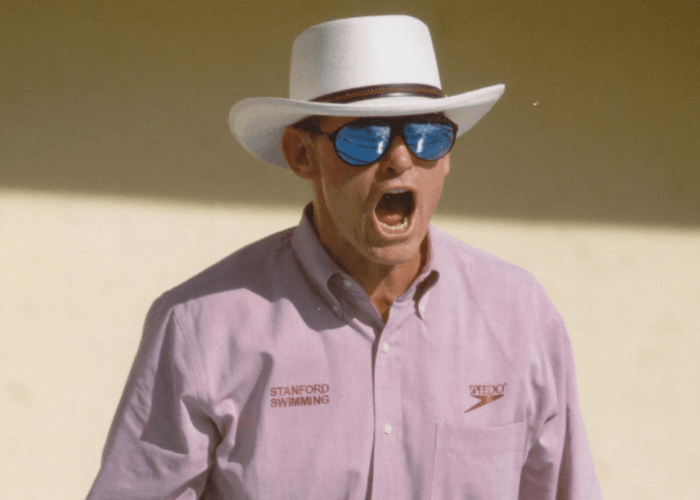
Photo Courtesy: Peter Bick
For his part, Quick didn’t try to sugarcoat the tension that built when they trained together. He was open and honest about the situation, and to his credit, Quick did a fine job of preparing both women to excel at the Olympic Trials.
“Every day in practice was like an Olympic final. I had to train them separately,” Quick said. “I just made the decision as a coach, because of the chemistry of the situation, to have them train at different times. There was a kind of chemistry situation that needed to be addressed. They deserved individual attention and I wanted to give it to them. They deserved it and they somewhat demanded it. When dealing with athletes who compete in the same events, that’s not so unusual.”
Once the Olympic Trials rolled around, Thompson and Torres engaged in their expected showdowns, with Thompson coming out on top in the 100 freestyle and 100 butterfly. Torres, meanwhile, finished first in the 50 freestyle. Although they were foes chasing the same hardware in Sydney, Thompson and Torres were teammates again, as was the case at the 1992 Olympics in Barcelona.
In Sydney, Thompson and Torres partnered toward a pair of gold medals, as they made up half of the United States’ 400 freestyle relay and 400 medley relay. Torres got the best of Thompson in the 100 butterfly, winning bronze while her rival was fifth, and also took bronze in the 50 freestyle. But it is what transpired in the 100 freestyle that is only believable because it is logged in the history books.
Placing behind the Netherlands’ Inge de Bruijn and Sweden’s Therese Alshammar in the 100 freestyle, Torres and Thompson tied for the bronze medal, thanks to matching times of 54.63. It was a fitting outcome and one that Torres called ironic based on the leadup to Sydney.
“There are three (things) to describe why I am where I am right now: Hard work, dedication and sacrifice,” Torres said. “I feel I’ve done everything I possibly can the right way to get where I am. I know it seems a little amazing because I’m 33 and I was out seven years. But for some reason, this was supposed to happen, and I’m just enjoying the ride.”
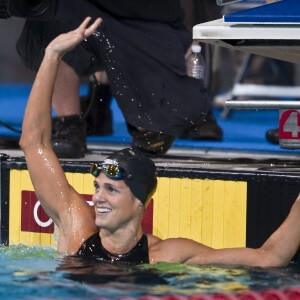
Photo Courtesy: Peter H. Bick
Following the 2000 Games, Torres opted for her second retirement while Thompson began her medical-school studies at Columbia University. After a year, Thompson returned to the pool and put together superb performances at the 2002 Pan Pacific Championships and 2003 World Championships. Thompson won the 50 free at Pan Pacs, to go with bronze medals in the 100 freestyle and 100 butterfly, and followed a year later by winning five medals at the World Champs, including gold in the 100 butterfly. It was a perfect setup to Thompson’s final Olympics, the 2004 Games in Athens.
At 31 years old, Thompson was seventh in the 50 freestyle and fifth in the 100 butterfly. Yet, she added the final two Olympic medals of her career as the United States won silver in the 400 freestyle relay and 400 medley relay. Afterward, it was back to medical school, with the knowledge she had finished her career on her terms.
“What keeps me going is finding out how far I can push myself,” she said. “How fast can I be? How long can I stay on top? That striving for excellence, that feeling of knowing you have trained till you don’t have one drop of energy left, that’s what keeps me happy.”
The retirement of Thompson figured to put an end to the days of America’s T&T tandem, until Torres made a second – and improbable comeback – in 2007. Upon returning for a second time, Torres didn’t waste time emphasizing the seriousness of her comeback. She won national titles in the 50 freestyle and 100 freestyle in 2007 and followed a year later, as a 41-year-old, with berths to the 2008 Olympics in Beijing in both sprint-freestyle events, an American record defining her win in the 50 free.
At the 2008 Games, Torres captured three silver medals, two of them earned in a 35-minute span on the final night of action. A silver already claimed in the 400 freestyle relay from earlier in the meet, Torres was the runnerup in the 50 free and as a member of the 400 medley relay. Her second-place finish in the 50 freestyle was by the slimmest of margins, as Germany’s Britta Steffen beat Torres, 24.06-24.07, a poor finish by Torres denying her the first solo gold of her Olympic career.
Torres became the oldest swimmer in history to medal at the Olympics and by raising her career total to 12 medals, she tied Thompson as the second-most decorated swimmer in Olympic history, behind Michael Phelps. She also became an inspiration to women around the world, proving that age does not have to be a hindrance.
“If it helps anyone else out there who is in their middle-aged years and they put off something they thought they couldn’t do because they were too old or maybe thought that because they have children they can’t balance what they want to do and be a parent, then I’m absolutely thrilled,” she said.
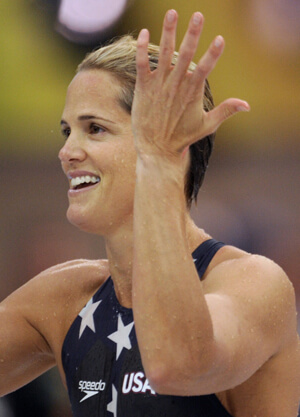 The first five-time Olympian for USA Swimming, Torres made another run at an Olympic bid in 2012 but finished fourth in the 50 freestyle at 45 years old. The sheer improbability of what Torres has achieved has been appreciated in many circles but has been questioned in others. Despite offering to be additionally tested, Torres has been accused of benefiting from performance-enhancing drugs.
The first five-time Olympian for USA Swimming, Torres made another run at an Olympic bid in 2012 but finished fourth in the 50 freestyle at 45 years old. The sheer improbability of what Torres has achieved has been appreciated in many circles but has been questioned in others. Despite offering to be additionally tested, Torres has been accused of benefiting from performance-enhancing drugs.
“It’s too bad,” Torres said of the doping speculation. “Why do people have to emphasize drugs because someone does something really fast? I don’t have words to describe it. It infuriates me. People think that because drugs are used so much in sport. Everyone has a conscience. For me, I know I’ve done everything I can do to get where I am the right way.”
The shortcoming shared by the Hall of Fame inductees is the lack of an individual gold medal on either woman’s ledger. But what Thompson and Torres achieved over a combined nine Olympiads outweighs the missing achievement. More, they gave the sport – and each other – something to follow in the Olympic campaign of 2000.
“We’re both very competitive,” Thompson said at the height of the rivalry. “We’re friendly when it comes down to it, but it hasn’t always been easy. We make the best of it. The rivalry definitely has pushed me to be better. It put me out of my comfort zone and made me have to step it up.”




Maria your swimmer Jenny Thompson!
Both great athletes?